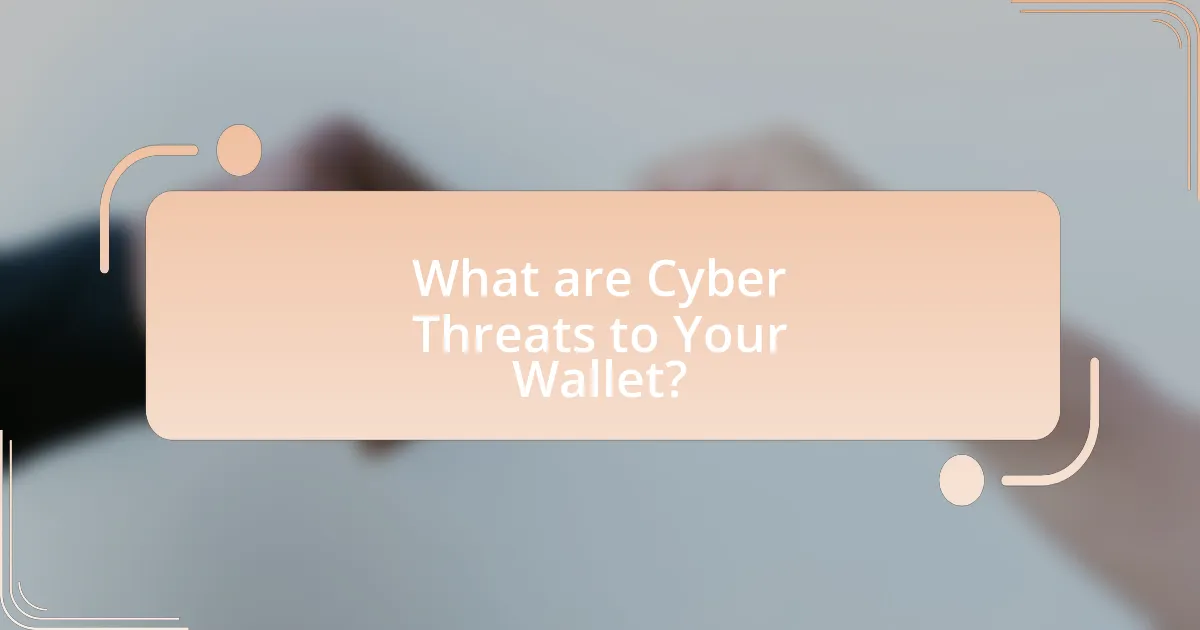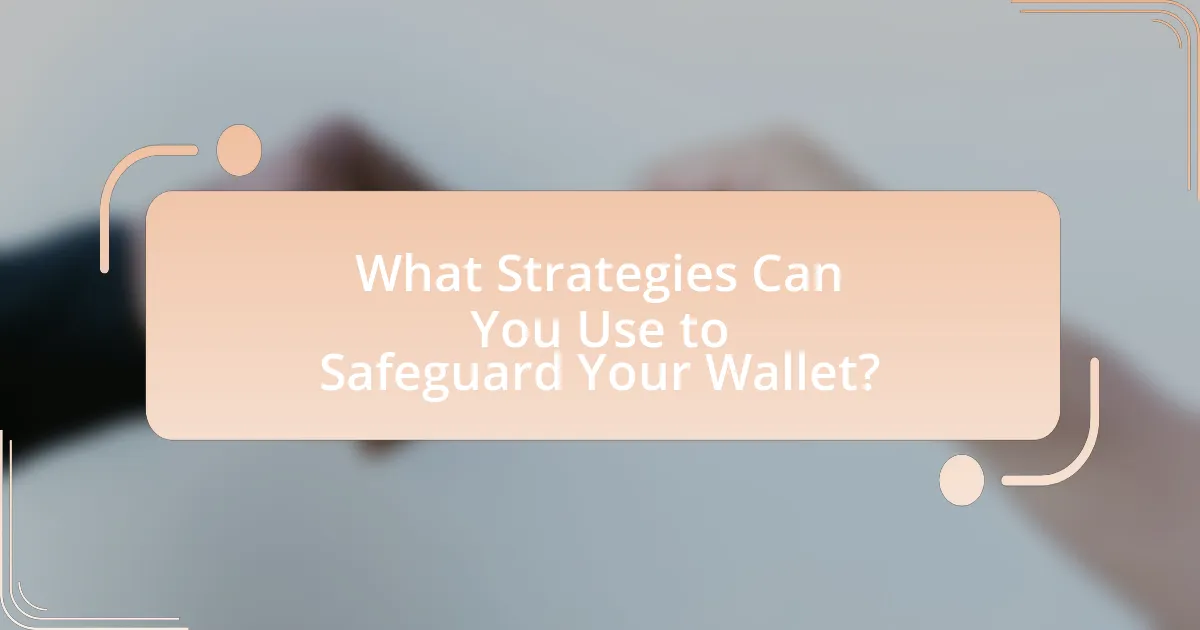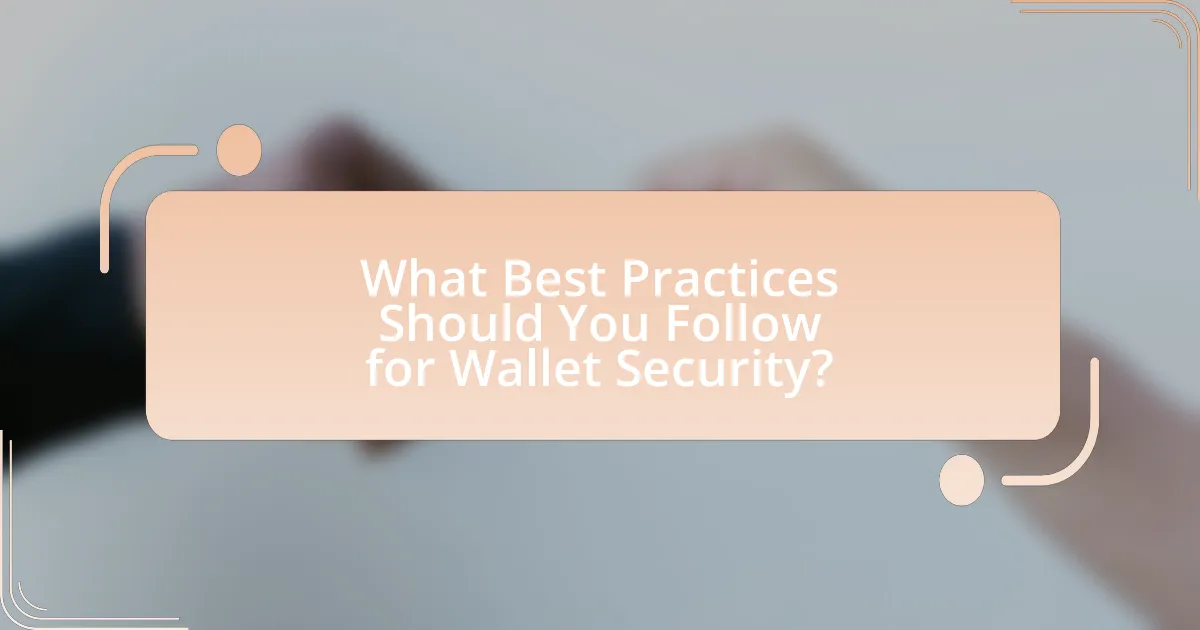The article focuses on safeguarding digital wallets from various cyber threats, including phishing attacks, malware, and identity theft. It outlines how these threats specifically target digital wallets and the common tactics employed by cybercriminals, such as man-in-the-middle attacks and keylogging. The article emphasizes the importance of implementing security measures like strong passwords, two-factor authentication, and regular software updates to protect financial information. Additionally, it provides practical tips for recognizing phishing attempts, responding to suspicious communications, and maintaining wallet security over time, highlighting the potential consequences of compromised wallets and the necessity of proactive security practices.

What are Cyber Threats to Your Wallet?
Cyber threats to your wallet include phishing attacks, malware, and identity theft. Phishing attacks involve deceptive emails or messages that trick individuals into revealing sensitive information, such as passwords or credit card numbers. Malware, which can be installed on devices through malicious downloads or links, can capture personal data or facilitate unauthorized transactions. Identity theft occurs when cybercriminals steal personal information to impersonate individuals and access their financial accounts. According to the Federal Trade Commission, in 2020, there were over 1.4 million reports of identity theft, highlighting the prevalence of this threat.
How do cyber threats specifically target digital wallets?
Cyber threats specifically target digital wallets through methods such as phishing, malware, and man-in-the-middle attacks. Phishing attacks deceive users into revealing their wallet credentials by impersonating legitimate services, with a 2021 report indicating that 74% of organizations experienced phishing attacks. Malware can be installed on devices to capture sensitive information, with a study showing that 60% of mobile malware targets financial applications. Man-in-the-middle attacks intercept communications between users and wallet services, allowing attackers to steal data without detection. These tactics highlight the vulnerabilities of digital wallets and the need for robust security measures.
What types of cyber threats are most common for wallet users?
Wallet users commonly face phishing attacks, malware, and keylogging as the most prevalent cyber threats. Phishing attacks involve fraudulent attempts to obtain sensitive information by masquerading as trustworthy entities, often through emails or fake websites. Malware, which includes viruses and ransomware, can compromise wallet security by infiltrating devices and stealing private keys or credentials. Keylogging software records keystrokes, allowing attackers to capture login information and access wallets without the user’s consent. According to the Cybersecurity & Infrastructure Security Agency (CISA), phishing is responsible for over 80% of reported security incidents, highlighting its significance as a threat to wallet users.
How can these threats compromise your financial information?
Cyber threats can compromise your financial information by exploiting vulnerabilities in digital systems, leading to unauthorized access and theft of sensitive data. For instance, phishing attacks trick individuals into revealing personal information, while malware can infiltrate devices to capture login credentials and financial details. According to the 2021 Verizon Data Breach Investigations Report, 36% of data breaches involved social engineering tactics, highlighting the effectiveness of these threats in targeting financial information.
Why is it important to safeguard your wallet from cyber threats?
Safeguarding your wallet from cyber threats is crucial to protect your financial assets and personal information from theft. Cybercriminals increasingly target digital wallets, with reports indicating that in 2021, losses from cryptocurrency thefts exceeded $14 billion, highlighting the significant risk involved. By implementing security measures, such as strong passwords and two-factor authentication, individuals can mitigate the risk of unauthorized access and potential financial loss.
What are the potential consequences of a compromised wallet?
A compromised wallet can lead to significant financial loss, as unauthorized access allows attackers to steal funds directly. Once a wallet is compromised, the owner may lose access to their cryptocurrencies or digital assets, resulting in irreversible financial damage. According to a report by Chainalysis, in 2021 alone, over $7.7 billion was stolen from cryptocurrency wallets due to hacks and scams, highlighting the severity of the consequences. Additionally, a compromised wallet can lead to identity theft, as personal information may be exposed, further exacerbating the financial and emotional toll on the victim.
How does safeguarding your wallet protect your overall financial health?
Safeguarding your wallet protects your overall financial health by preventing unauthorized access to your funds and personal information. When you implement security measures such as strong passwords, two-factor authentication, and encryption, you reduce the risk of theft and fraud. According to the Federal Trade Commission, identity theft affected over 1.4 million consumers in 2020, leading to significant financial losses. By securing your wallet, you mitigate these risks, ensuring that your financial resources remain intact and accessible only to you.

What Strategies Can You Use to Safeguard Your Wallet?
To safeguard your wallet from cyber threats, implement multi-factor authentication (MFA) for all financial accounts. MFA adds an extra layer of security by requiring not only a password but also a second form of verification, such as a text message code or biometric scan. According to a study by the Cybersecurity & Infrastructure Security Agency, using MFA can block up to 99.9% of automated cyber attacks, significantly reducing the risk of unauthorized access to your financial information. Additionally, regularly updating your passwords and using unique passwords for different accounts further enhances security, as weak or reused passwords are a common vulnerability exploited by cybercriminals.
How can you enhance the security of your digital wallet?
To enhance the security of your digital wallet, implement strong, unique passwords and enable two-factor authentication (2FA). Strong passwords should consist of at least 12 characters, including a mix of uppercase letters, lowercase letters, numbers, and symbols, making them harder to crack. According to a study by the National Institute of Standards and Technology, using 2FA can reduce the risk of unauthorized access by 99.9%. Additionally, regularly updating your wallet software and monitoring your account for suspicious activity further strengthens security.
What role do strong passwords play in wallet security?
Strong passwords are crucial for wallet security as they significantly reduce the risk of unauthorized access. A strong password typically includes a combination of uppercase and lowercase letters, numbers, and special characters, making it difficult for attackers to guess or crack through brute force methods. According to a study by the National Institute of Standards and Technology (NIST), using complex passwords can decrease the likelihood of a successful cyber attack by up to 80%. Therefore, implementing strong passwords is a fundamental step in protecting digital wallets from cyber threats.
How can two-factor authentication improve wallet protection?
Two-factor authentication (2FA) significantly enhances wallet protection by requiring an additional verification step beyond just a password. This added layer of security ensures that even if a password is compromised, unauthorized access to the wallet remains unlikely. For instance, a study by Google and the University of California, Berkeley, found that 2FA can block 99.9% of automated attacks, demonstrating its effectiveness in safeguarding sensitive information. By implementing 2FA, users can protect their wallets from unauthorized transactions and potential theft, thereby improving overall security against cyber threats.
What software and tools can help protect your wallet?
To protect your wallet, software and tools such as antivirus programs, password managers, and two-factor authentication apps are essential. Antivirus programs like Norton or McAfee can detect and eliminate malware that targets financial information. Password managers, such as LastPass or Dashlane, securely store and encrypt your passwords, reducing the risk of unauthorized access. Two-factor authentication apps, like Google Authenticator or Authy, add an extra layer of security by requiring a second form of verification when accessing accounts. These tools collectively enhance wallet security by preventing unauthorized access and safeguarding sensitive information.
Which antivirus programs are recommended for wallet security?
Recommended antivirus programs for wallet security include Bitdefender, Norton, and Kaspersky. Bitdefender offers advanced anti-phishing features that protect online transactions, while Norton provides a secure VPN and dark web monitoring to safeguard sensitive information. Kaspersky is known for its robust malware protection and real-time security updates, which are crucial for protecting digital wallets. These programs have consistently received high ratings from independent testing labs, confirming their effectiveness in securing financial data against cyber threats.
How can encryption tools safeguard your wallet data?
Encryption tools safeguard wallet data by converting sensitive information into a coded format that is unreadable without a decryption key. This process protects the data from unauthorized access, ensuring that even if cybercriminals intercept the data, they cannot decipher it. For instance, strong encryption algorithms like AES (Advanced Encryption Standard) are widely used to secure financial transactions and personal information, making it extremely difficult for attackers to access or manipulate the data. According to a report by the National Institute of Standards and Technology, encryption is a critical component in protecting data integrity and confidentiality, thereby significantly reducing the risk of data breaches.

What Best Practices Should You Follow for Wallet Security?
To ensure wallet security, implement strong passwords, enable two-factor authentication, and regularly update software. Strong passwords should be complex, combining letters, numbers, and symbols, making them difficult to guess. Two-factor authentication adds an extra layer of protection by requiring a second form of verification, significantly reducing the risk of unauthorized access. Regular software updates patch vulnerabilities that cybercriminals may exploit, thereby enhancing security. According to a 2021 report by Cybersecurity Ventures, 60% of small businesses experience a cyber attack, highlighting the importance of these practices in safeguarding digital wallets.
How can you recognize phishing attempts targeting your wallet?
Phishing attempts targeting your wallet can be recognized by identifying suspicious emails, messages, or websites that request sensitive information. These attempts often contain poor grammar, generic greetings, and urgent language urging immediate action, which are common indicators of fraudulent communications. Additionally, legitimate organizations typically do not ask for sensitive information via email or direct messages. According to the Anti-Phishing Working Group, in 2021, over 70% of phishing attacks were aimed at stealing personal information, highlighting the prevalence of such tactics. Always verify the sender’s email address and look for inconsistencies in URLs before providing any information.
What signs indicate a potential phishing attack?
Signs that indicate a potential phishing attack include unsolicited emails or messages that create a sense of urgency, such as threats to suspend an account or claims of unauthorized transactions. These communications often contain suspicious links or attachments that lead to fraudulent websites designed to steal personal information. Additionally, poor spelling and grammar in the message can be a red flag, as legitimate organizations typically maintain high standards in their communications. According to the Anti-Phishing Working Group, phishing attacks have increased significantly, with over 200,000 reported incidents in a single month, highlighting the importance of recognizing these signs to protect against cyber threats.
How should you respond to suspicious communications?
To respond to suspicious communications, you should first avoid engaging with the sender and refrain from clicking on any links or downloading attachments. This action is crucial because many cyber threats, such as phishing attacks, rely on users interacting with malicious content. According to the Anti-Phishing Working Group, in 2021, over 83,000 unique phishing sites were reported, highlighting the prevalence of such threats. Instead, report the communication to your email provider or the relevant authority, as this helps in tracking and mitigating cyber threats. Additionally, consider updating your security software to protect against potential malware that may have been introduced through the suspicious communication.
What are the best practices for maintaining wallet security?
The best practices for maintaining wallet security include using strong, unique passwords, enabling two-factor authentication, and regularly updating wallet software. Strong passwords should consist of a mix of letters, numbers, and symbols, making them difficult to guess. Two-factor authentication adds an extra layer of security by requiring a second form of verification, such as a text message or authentication app. Regular software updates ensure that any vulnerabilities are patched, reducing the risk of exploitation by cyber threats. According to a report by the Cybersecurity & Infrastructure Security Agency, implementing these practices significantly decreases the likelihood of unauthorized access to digital wallets.
How often should you update your wallet software?
You should update your wallet software regularly, ideally every time a new version is released. Regular updates are crucial because they often include security patches that protect against vulnerabilities. For instance, a study by the Cybersecurity & Infrastructure Security Agency (CISA) indicates that outdated software is a primary target for cyber threats, making timely updates essential for safeguarding digital assets.
What steps should you take if you suspect your wallet has been compromised?
If you suspect your wallet has been compromised, immediately change your wallet’s password and enable two-factor authentication if available. This action helps secure your account from unauthorized access. Next, review your transaction history for any unauthorized transactions and report them to your wallet provider. According to the Federal Trade Commission, promptly reporting unauthorized transactions can help mitigate financial losses. Additionally, consider moving your funds to a new wallet to prevent further unauthorized access. Regularly monitoring your accounts and using strong, unique passwords can further enhance your security against future threats.
What practical tips can you implement to safeguard your wallet?
To safeguard your wallet, implement the following practical tips: use strong, unique passwords for your digital wallet, enable two-factor authentication, and regularly update your software. Strong passwords reduce the risk of unauthorized access, while two-factor authentication adds an extra layer of security by requiring a second form of verification. Regular software updates patch vulnerabilities that cybercriminals may exploit. According to a 2021 report by Cybersecurity Ventures, 60% of small businesses experience a cyber attack, highlighting the importance of these protective measures.
How can regular monitoring of your wallet transactions enhance security?
Regular monitoring of wallet transactions enhances security by allowing users to quickly identify unauthorized or suspicious activities. By consistently reviewing transaction history, individuals can detect anomalies such as unexpected withdrawals or transfers, which may indicate potential fraud or hacking attempts. Studies show that timely detection of such activities can significantly reduce the risk of financial loss; for instance, the Federal Trade Commission reported that consumers who act quickly upon noticing fraudulent transactions can recover up to 80% of their lost funds. Therefore, regular monitoring serves as a proactive measure to safeguard against cyber threats.
What habits should you develop to maintain wallet security over time?
To maintain wallet security over time, individuals should develop habits such as regularly updating passwords, enabling two-factor authentication, and monitoring account activity. Regularly updating passwords reduces the risk of unauthorized access, as outdated passwords can be easily compromised; a study by the Ponemon Institute found that 81% of data breaches are due to weak or stolen passwords. Enabling two-factor authentication adds an extra layer of security, making it significantly harder for attackers to gain access even if they have the password. Monitoring account activity allows individuals to quickly identify and respond to any suspicious transactions, which is crucial for minimizing potential losses.